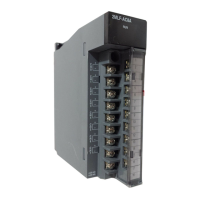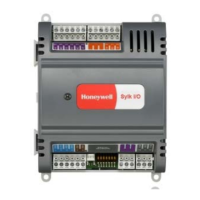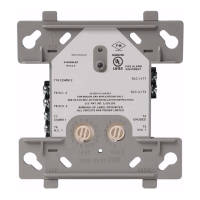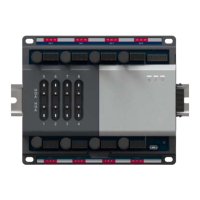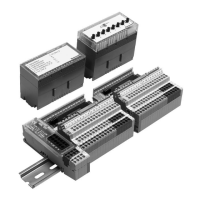Do you have a question about the Honeywell ALERTON ACM-VLX and is the answer not in the manual?
| Brand | Honeywell |
|---|---|
| Model | ALERTON ACM-VLX |
| Category | I/O Systems |
| Language | English |
Failure to follow instructions may result in equipment damage or hazardous conditions.
Install equipment according to National Electric Code and local authority.
Handle product by non-electrical components to prevent ESD damage.
Always assume hazardous voltages exist; perform safety checks.
Avoid electrical work during storms; protect wiring from surges.
Maintain separation between power and communications wiring.
Guidance on manual navigation, cross-referencing, and using appendices.
Reference to related Alerton documents for comprehensive system knowledge.
Function of ACM-VLX as a virtual device within ACM, including license limits.
Interdependent operation of VLX, EXPs, AXMs, and their network capabilities.
Capabilities, configuration procedures, wiring, and overrides for VLX/ACM-VLX.
Instructions for mounting VLX, ACM-VLX, EXP, and AXM devices in enclosures.
Essential grounding practices for reliable operation and communication.
Steps for terminating cables to terminal blocks on VLX/ACM-VLX/EXP/AXM.
Power requirements for VLX unit, including transformer sizing and voltage thresholds.
Power requirements for EXP/AXM units and rules for transformer sharing.
Procedure to determine appropriate transformer VA ratings for unit and BO power.
Guide to choosing correct cable gauge for 24 VAC power supply runs.
Details the 18 AWG twisted shield cable bus for EXP/AXM communication.
Identifies terminals for EXP/AXM, VLX, and ACM communication buses.
Specifies cable requirements for EXP/AXM communication, including length limits.
Instructions for terminating shield drains for EXP/AXM communication bus.
Explains setting unique addresses for EXPs/AXMs using DIP switches.
Preferred connection method for VLX/ACM-VLX to BACnet networks.
Details the MS/TP LAN standard and its use for BACnet applications.
Description of binary output arrangement and H-O-A switch on EXP/AXM units.
AO configuration via DIP switches for current (0-20mA) or voltage (0-10VDC) output.
Details universal input types (resistance, voltage, current, dry contact) and jumper settings.
Wiring and jumper settings for thermistors and potentiometers.
Wiring and jumper settings for dry contact inputs.
Wiring scenarios for 4-20mA devices, including power options.
Wiring for three-wire 0-5VDC devices, including power and signal connections.
Wiring for three-wire 0-10VDC devices, including power and signal connections.
Wiring for solid-state (transistor) switches to input terminals.
Wiring and jumper settings for pulse-type inputs on specific terminals.
Instructions for initial firmware configuration using HyperTerminal and an AC-2650 cable.
Procedures for navigating menus, entering data, and saving changes in HyperTerminal.
Setting network and device configurations via the Change Configuration menu.
Configuration of Ethernet network parameters like enablement and network number.
Configuration of MS/TP network parameters like network number and MAC address.
Information on EXP/AXM communication speed settings.
Configuration options for Point-to-Point (PTP) connections.
Configuration of BACnet/IP parameters for network interoperability.
Critical steps for setting the device's date and time for proper operation.
Steps for confirming network, setting inputs, downloading DDC, and automation features.
Adding the VLX/ACM-VLX to Device Manager for ongoing management.
Verifying communication status between EXP/AXM and VLX/ACM-VLX.
Configuring input types, scaling, and filtering for EXP/AXM inputs.
Adjusting Zero and Range AVs to scale AI inputs for desired ranges.
Configuring software filtering to stabilize input readings and reduce fluctuations.
Configuring pulse inputs and setting Time Base and Pulse Value AVs.
Programming backup mode values for analog and binary outputs.
How VLX/ACM-VLX and EXPs/AXMs are represented as BACnet objects.
Defines variables (e, nn) for referencing EXP/AXM data and objects.
Details analog and binary inputs, conversion, and state logic.
Describes analog and binary output objects and their terminal association.
Explains commanding outputs and the role of the priority array.
Guidance on reading AO/BO present-values in DDC to avoid issues.
Details Binary Output behavior, H-O-A switch, and anti-cycle properties.
Explains Analog Output control signals, H-O-A switch, and trimpot functionality.
Describes Analog Values (AVs) and Binary Values (BVs) for special uses and programming.
Information on monitoring DDC execution time and memory usage.
Highlights DDC programming aspects like branch points and current time.
Explains VLX diagnostic LEDs for status and troubleshooting.
Interpreting the STATUS LED on EXP/AXM for communication status.
How to use H-O-A switches and trimpots for manual override of AO/BO outputs.
Details the sequence when EXP/AXM enters backup mode due to lost communication.
Procedure for saving and restoring controller configuration and setup data.
Step-by-step guide for replacing the coin-cell battery.
Procedures for resetting VLX, clearing DDC, objects, and ROC files.
Guide to running a comprehensive field test to identify internal VLX failures.
Details properties for Analog Input (AI) objects.
Details properties for Analog Output (AO) objects.
Details properties for Analog Value (AV) objects.
Details properties for Binary Input (BI) objects.
Details properties for Binary Output (BO) objects.
Details properties for Binary Value (BV) objects.
Details properties of the VLX/ACM-VLX Device object.
Details properties for Event Enrollment objects.
Details properties for File objects.
Details properties for Notification Class objects.
Details properties for Program objects.
Details properties for Schedule objects.
Worksheet for configuring inputs for EXP 0.
Worksheet for configuring inputs for EXP 1.
Worksheet for configuring inputs for EXP 2.
Worksheet for configuring inputs for EXP 3.
Worksheet for configuring inputs for EXP 4.
Worksheet for configuring inputs for EXP 5.
Worksheet for configuring inputs for EXP 6.
Worksheet for configuring inputs for EXP 7.

